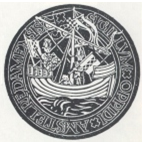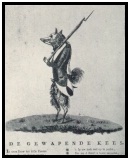History of the Keeshond
1.jpg)
MBIS/MBISS CH Rymiska Kzam
The Keeshond is recognized as a Spitz Breed, along with the Samoyed, Siberian Husky, Alaskan Malamute, Chow chow, Norwegian Elkhound, Pomeranian and many others. This group of dogs are characterised by dense, thick and profuse coat, pointed ears and muzzles with tails usually curled over the dog’s back. The word Keeshond is a two syllable word where the first syllable ‘Kees’ derived from the nickname for Cornelius de Gyselaar, the Patriot Rebellion Leader who we will learn more about below. The second syllable ‘hond’ means ‘dog’ in Dutch and together we pronounce them as Caze-Hawnd.
Through the record findings of palaeontologists, the Keeshond has been tracked back through the ages to fossil remains of Canis Familiaris Palustris of the Neolithic or Late Stone Age (5000 B.C), found mainly in northern areas of the globe. Art objects found in these areas support the theory that the Keeshond originally came from the north on ancient water craft such as the Great Seal of Amsterdam which shows an ancient vessel with a Spitz looking dog peering over the gunnels of the ship.

Following the legend, it is believed that the Keeshond played a promindent role in how Amsterdam was established. A Viking ship is said to have foundered on the Friesland coast near Stavoren and all hands were drowned except one, a Chieftain’s son. Accompanied by his dog, A Friesian fisherman named Wolfert, who was a Christian, rescued the invader and the two men and the dog set sail on Wolfert’s fishing boat. In the dead of night a fierce storm drove them south, deep into unknown waters, but they finally drifted to safety onto high ground. In gratitude for their deliverance. Wolfert and the Norseman built a small chapel, which they dedicated to St. Olav, Patron Saint of Mariners. Wolfert’s dog was witness to all this. Here the legend ends and straight history takes over. In the course of time, a small fishing village came into being on the spot where Wolferts boat is supposed to have landed – the spot where the Amstel River flowed into the inland sea. A series of great storms during the 13th century widened and deepened nearby waters until it became the Zuider Zee. A dam was built across the river and the little town came to be known as Amstelredam. No one could have guessed it would become the metropolis of Amsterdam.
The people of Amsterdam never forgot the legend or the dog. To carry a dog on a vessel was first considered a good omen and developed into a custom. In time the dog became part of the sea laws because it came to represent ownership. No one dared ransack a ship if a dog was on board.
Since early times, most barges, farms and carts had a canine sentry, usually a Keeshond or whatever name he was given in the various countries. He was also a guard for flocks and sometimes used to hunt skunks. However, we must dispel the notion, often expressed even today, that the dog ever pulled barges. Barges were cargo vessels with living quarters for the captain and his family, and the dogs lived on board as zealous guardians of their owners’ properties and playmates for their children.
Historical events in the Netherlands in the late 1700s, combined with the breed’s popularity in that country, made the Keeshond internationally known in Europe. In about 1781, Holland was divided into two political factions: the Orangists (Conservatives) who supported the Prince of Orange as Governor of the Netherlands, and the rebellious patriots (or Keezen, as the pro-Orange men derisively referred to the people’s party members). Cornelius de Gyselaar, who had one of these popular dogs as his constant companion, was a leader in the patriot’s revolt. Remembering that “Kees” a nickname in the Netherlands for Cornelis or Cornelius it seems significant in regard to a basis for the breed’s name that “Kees” de Gyselaar’s “hond” became the emblem of the Dutch party.

It is believed that after suppression of the patriot’s rebellion, many Kees were done away with for fear that possession of the dogs would indicate affiliation with the defeated rebels. Thus, this beautiful and popular breed paradoxically became the victim of its own fame. Although some barge captains and farmers retained their dogs and kept informal stud records for their own use, it was more than a century later before the Keeshond again came to public attention. During World War 1, the breed in Germany suffered for lack of available food and was greatly reduced in numbers.The fact that he is the most loyal companion helped towards his depletion. In both world wars he suffered: in the first through lack of food, and in the second he was used by the resistance for taking messages. When the Nazis realised this, they were shot when seen.
In 1903 a Mrs. Patrick Morrel acquired her first Kees bitch from a Mrs. Potts. Much discussion and disagreement took place around this time as to whether it was a Wolf Spitz or an overweight Pom. In 1911 a Miss Beverley showed what she called a Kees dog at LKA. In 1916 CCs were withdrawn from overweight Poms and the breed was no longer heard of until its appearance as the Dutch Barge Dog in 1925.
Meanwhile a tour of Holland by a young English girl had laid the foundation for great and lasting enthusiasm for Kees in Great Britain. .As the founder of the breed in England, with a life-long dedication to Keeshonds, a Mrs Wingfield Digby of the famous van Zaandom Kennels, was yachting in Holland with her parents in 1905. Mrs Digby, then Miss Hamilton Fletcher, found the beautiful watchdogs seen on Dutch Barges so appealing that she bought two wolf-grey puppies from a gold-earringed skipper. These were called Barkles and Zaandam, and were followed by Schie, Edam, Dirk and Comelius. Later, more from Germany followed for the famous kennel at Sherborne Castle.
The first official Dutch Barge Dog was shown in 1923 and a specialist club in the UK was formed in 1925. In 1926 it was renamed The Keeshond Club and enjoyed a strong membership of 206. In 1928 CCs were allotted for Keeshonds in the Uk.
The development of the Keeshond in Australian really began in 1949 when Mrs Bourne emigrated from England. She brought with her four Keeshonds; CH Airking of Arnhem, CH Valies of Vorden, Airamber of Arnhem and Babette of Willowden. These dogs became the foundations of the Australian lines in the 1950’s and 1960’s. Keeshonds were first exhibited at the prestigious Sydney Royal Show in 1952 and at the Melbourne Royal Show in 1954. The breed slipped into a slight obscurity until the Keeshond clubs of both New South Wales and Victoria were established in 1967. One of the Keeshond Club of Victoria’s founders, Mrs Ruth Taylor of the Kendari prefix imported CH Ensign of Duroya, whom helped increased the popularity and the quality of the breed once again during the 1970’s, leaving an indelible impression on the pedigrees that followed. In 1990, the Keeshond Club of South Australia was formed and then affiliated with the South Australian Canine Association in 1997.
Over the years, imports from all over the world have been brought into the country to continue to strengthen and widen the gene pool. Early imports included Van Zaandam, Duroya, Gavimir, Hanovarian, Vandaban, Waakzaam and Keesland lines. Recent times have seen new lines from the USA, England, Canada, New Zealand, Finland and Sweden and through the use of artificial insemination we have also been able to utilize frozen semen into breeding programs. Australia has also had many successful exports of dogs and frozen semen to many different countries.
References:
‘My Life with Keeshonden’ by Gwendolen Wingfield Digby
‘The New Complete Keeshond’ by Carol & Ron Cash
‘The History of the Keeshond’ by Jean Sharp-Bale from the Keeshond Club of UK website
Contact Details
Stuart Presland & Tracey ParkerKenthurst, NSW, Australia
Phone : +61438407497
Email : [email protected]